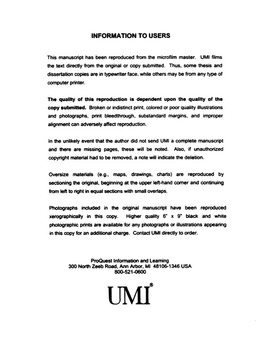| dc.contributor.advisor | Gardner, James, | en_US |
| dc.contributor.advisor | Martin, James, | en_US |
| dc.contributor.author | Walden, Robert J. | en_US |
| dc.date.accessioned | 2013-08-16T12:18:36Z | |
| dc.date.available | 2013-08-16T12:18:36Z | |
| dc.date.issued | 2002 | en_US |
| dc.identifier.uri | https://hdl.handle.net/11244/482 | |
| dc.description.abstract | One-on-one instruction was the method of presentation of the materials. Video taping of each session permitted verification of presentation consistency. Each session was video taped to verify and grade consistency of presentation. The successful acquisition, generalization to a new behavior, and generalization over time and setting-time was repeatedly measured over a nine to eleven month period. | en_US |
| dc.description.abstract | A stringent test of generalization indicated that the students generalized the acquired goal attainment knowledge and skills to a totally new behavior. The students' generalization scores after intervention indicated a convincing level of generalization (see Table 16 and Figure 2). These impressive levels of generalization did deteriorate over the three to four months between the end of intervention and the next probe of the students (see Table 19). Deterioration of the generalized behavior of all students continued through the end of the project. However, only one student dropped below his initial baseline score (see Table 34 and Table 16). The students not only learned the goal attainment knowledge and skills, they were also able to generalize that teamed information to a totally new behavior. These results indicated the most impressive finding of the research in that the intervention taught knowledge and skills thoroughly enough to affect a behavior change that generalized over a relatively long period of time (3 to 7 months) with evidence at the end of the research that was above the baseline level of 4 of the 5 students (see Table 34). | en_US |
| dc.description.abstract | The Take Action materials successfully taught five college students with learning disabilities a goal attainment process. Three of the five students had criterion or better total scores on all seven acquisition measures. The group as a whole scored criterion or better on six of the seven acquisition measures indicating that the materials taught the goal attainment process to this group of students (see Table 10). | en_US |
| dc.description.abstract | The results of the research are a definite proof that a substantial amount of learning did occur during the intervention of instruction from the Take Action: Making Goals Happen instructional materials. | en_US |
| dc.description.abstract | A multiple baseline design across subjects and behaviors controlled threats to internal validity and evaluated acquisition and generalization to a new behavior. The students' scores on the Behavior Generalization Take Action Goal form was the primary dependent variable. Secondary dependent variables included scores on the Take Action Quizzes, ChoiceMaker Assessment Scale: Take Action Section, Air Self-Determination Scale, Self-Determination Knowledge Scale, Approach to Learning Scale, and the Self-Regulation Behaviors Scale. The Take Action: Making Goals Happen instructional materials served as independent variable. The demonstrated change in the dependent variable across individuals, skills, over time, and setting time generalization served as the primary focus to determine the efficacy of the teaching materials. | en_US |
| dc.description.abstract | The primary objective of the research was to determine if the teaching materials in the Take Action: Making Goals Happen section of the ChoiceMaker Instructional series (Huber Marshall et al., 1999) would teach the Take Action goal attainment process to college students with disabilities. Additionally, it was asked if the instruction would be sufficient enough to cause generalization to a new untrained behavior and generalize over both time and setting time conditions. | en_US |
| dc.format.extent | xvii, 163 leaves : | en_US |
| dc.subject | Marshall, Laura Huber. Take action. | en_US |
| dc.subject | Autonomy (Psychology) Study and teaching (Higher) | en_US |
| dc.subject | Education, Special. | en_US |
| dc.subject | Decision making Study and teaching (Higher) | en_US |
| dc.subject | Education, Higher. | en_US |
| dc.subject | Goal (Psychology) Study and teaching (Higher) | en_US |
| dc.subject | Education, Teacher Training. | en_US |
| dc.title | Teaching a goal attainment process to university students with learning disabilities. | en_US |
| dc.type | Thesis | en_US |
| dc.thesis.degree | Ph.D. | en_US |
| dc.thesis.degreeDiscipline | Department of Educational Psychology | en_US |
| dc.note | Major Professors: James Martin; James Gardner. | en_US |
| dc.note | Source: Dissertation Abstracts International, Volume: 63-05, Section: A, page: 1786. | en_US |
| ou.identifier | (UMI)AAI3054049 | en_US |
| ou.group | Jeannine Rainbolt College of Education::Department of Educational Psychology | |
